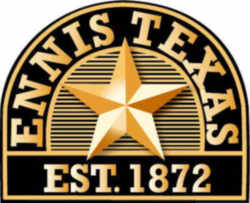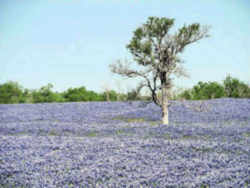
Texas Symbols
- State Resources
- » 50 States
- » Texas
- » Symbols
Texas State Bluebonnet City
City of Ennis

Adopted on June 18, 1997.
Ennis was designated the Bluebonnet City of Texas when Governor George W. Bush signed House Concurrent Resolution No. 116 on June 19, 1997. The past 46 years Ennis has been associated with the official wildflower of Texas and the faithful efforts of the Ennis Garden Club in preserving our state wildflower for all to enjoy. It was adopted on June 18, 1997.
Texas State Bluebonnet City: City of Ennis

In 1871, the Houston and
Texas Central Railroad (H&TC) purchased 647 acres of land in Ellis County at a price of $5.00 per acre, establishing the line's northern terminus.
On May 8, 1872 this site was established as the City of Ennis. The namesake of the town was Cornelius Ennis, an early official of
the Houston and Texas Central Railroad. Ennis served as Mayor of Houston (1856-1857), was an incorporator and director of the Great Northern Railroad,
and served as a director of the H&TC Railroad.
The railroad was the key to the development of Ennis as an agricultural, commercial, and later, an industrial center. In 1920, a total of 152,601 bales
of cotton were ginned in Ellis County, the most in any county in America. By 1930, Ennis was known as the place "Where Railroads and Cotton Fields
Meet."
For over 125 years, Ennis has successfully repositioned its strategic business focus from railroad, to agriculture, to modern industry.
The City of Ennis, located on Interstate Highway 45 just 30 minutes from downtown.
City of Ennis Fast Facts |
|
|---|---|
State |
Texas |
| Region | North Central Texas |
| County | Ellis |
| County Population | 111,360 (Ellis County- US Census 2000) |
| Altitude | 500 - 850 Feet (MSL) |
| Navigational Location | 32 Minutes 19.7° (Lat) / 96 Minutes 39.8° (Long) |
| Date of Incorporation | May 2, 1872 |
| City Charter Adopted | October 17, 1913 |
| Type of Government | Home Rule |
| Form of Government | City Commission / City Manager |
| Miles of Street | 97.3 (Approximate) |
|
Area in Square Miles |
19.3 (City of Ennis, 2002 Approximate) |
| City Population | 17,200 ( US Census 2000, City of Ennis 2002 Estimate) |
|
Population Density (Population/Square Mile) |
891.19 (City of Ennis, 2002 Approximate) |
| Number of Households | 5,708 (US Census 2000, City of Ennis 2002 Estimate) |
| Total School Enrollment |
5,307 (E.I.S.D. 2002-2003 Enrollment Data) |
|
Municipal Bond Rating (FY 2000 - 2001) |
"A" (Standard & Poor's) / "A3" (Moody's Investor Service) |
| Sales Tax | 7.75% (Combined City & State) |
|
Ad Valorem Tax Rate (Per $100 Valuation) |
$2.633 (Combined City, County, EISD) |
| Taxable Property Value |
$681,132,897.00 |
| Unemployment Rate | 4.8% (2001 - EOY Average) |
|
Full-Time |
167 (Number FTEs) |
|
Fire Protection |
30 (Number of Employees) |
| Fire Protection | 2(Number of Stations) |
| Police Protection | 42 (Number of Employees) |
| Police Protection | 1(Number of Stations) |
| Municipal Water Plant | 6,813 (Number of Customers Metered) |
| Estimated Gallons Billed |
943,726,000 (Annually) |
| Water Plant Capacity |
6.0 MGD (Million Gallons Per Day) |
| Water Storage Capacity |
3,500,000 Gallons |
|
Wastewater Plant |
2.5 MGD (Million Gallons Per Day) |
House Concurrent Resolution No 116
HOUSE CONCURRENT RESOLUTION H.C.R. No. 116
WHEREAS, In April 1997, thousands of residents and visitors alike will gather in Chappell Hill for one of our state's most popular and colorful yearly
events, the 33rd Annual Chappell Hill Bluebonnet Festival; and
WHEREAS, A much anticipated celebration of spring, the festival honors the spectacular bluebonnets that grace the community of Chappell Hill each April
with their seasonal display of eye-catching blooms; and
WHEREAS, This popular event is sponsored by the Chappell Hill Historical Society, and it began in 1964 as the Bluebonnet Antique Show; the festival
became known by its present name in 1983, and it currently offers fun-filled activities for the entire family, including a hayride through the community's
historic district and abundant opportunities to shop for distinctive wares and furniture from arts, crafts, and antique vendors; and
WHEREAS, The Chappell Hill Bluebonnet Festival will provide a time for many citizens to set aside the cares of daily life and enjoy the flowering beauty
of our Texas spring; this well-loved event continues to be a splendid addition to our state's array of recreational opportunities and is truly deserving
of legislative praise and support; and
WHEREAS, In 1951 the Ennis Garden Club established its first Bluebonnet Trail of Texas, mapping certain locales in the City of Ennis and the area surrounding
the city, thus sharing its bounty of this unique Texas wildflower; these mapped trails have grown to encompass more than 40 miles where the thousands
of visitors may be enthralled for two consecutive weekends in April each year by the spectacular fields of bluebonnets that grow so bountifully in
the area; the City of Ennis has gained renown for having the official Bluebonnet Trail of Texas; an added attraction to those visiting during the weekends
of the Bluebonnet Trail is an antique show and sale that attracts vendors from five neighboring states and benefits the Ennis Heritage Society; now,
therefore, be it
RESOLVED, That Ennis be declared the official Bluebonnet Trail of Texas and that Ennis be designated the Bluebonnet City of Texas because of
the 46 years it has been associated with the official wildflower of Texas and the faithful efforts of the Ennis Garden Club in preserving our state
wildflower for all to enjoy; and, be it further
RESOLVED, That the 75th Legislature of the State of Texas hereby designate the Chappell Hill Bluebonnet Festival as the official Bluebonnet Festival
of Texas and commend all those associated with the event for their hard work in ensuring its success.
House Concurrent Resolution No. 116, 75th Legislature, Regular Session (1997)







